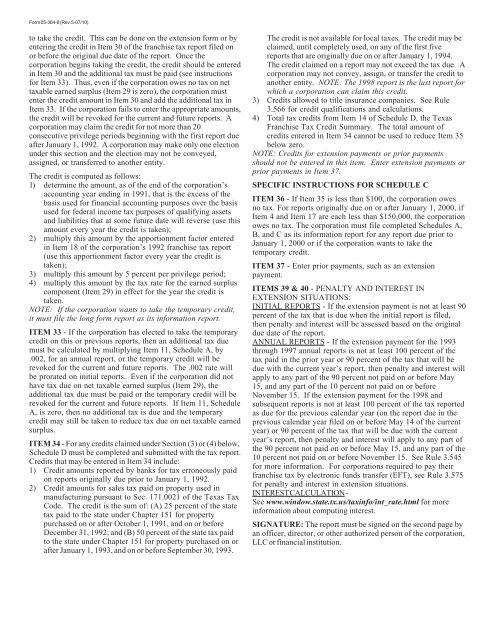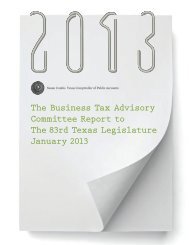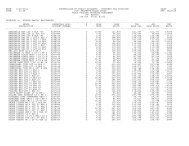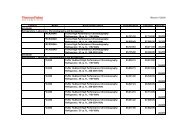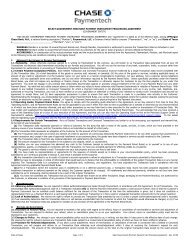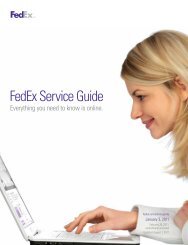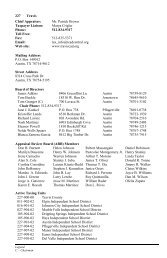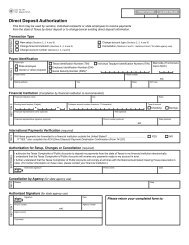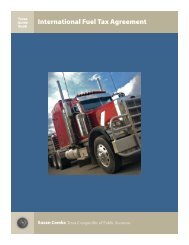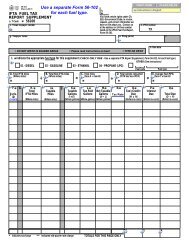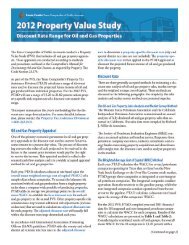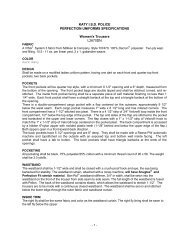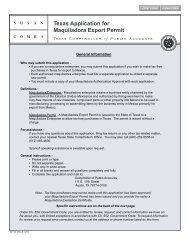Instructions for completing franchise tax reports originally due
Instructions for completing franchise tax reports originally due
Instructions for completing franchise tax reports originally due
Create successful ePaper yourself
Turn your PDF publications into a flip-book with our unique Google optimized e-Paper software.
Form 05-364-8 (Rev.5-07/10)to take the credit. This can be done on the extension <strong>for</strong>m or byentering the credit in Item 30 of the <strong>franchise</strong> <strong>tax</strong> report filed onor be<strong>for</strong>e the original <strong>due</strong> date of the report. Once thecorporation begins taking the credit, the credit should be enteredin Item 30 and the additional <strong>tax</strong> must be paid (see instructions<strong>for</strong> Item 33). Thus, even if the corporation owes no <strong>tax</strong> on net<strong>tax</strong>able earned surplus (Item 29 is zero), the corporation mustenter the credit amount in Item 30 and add the additional <strong>tax</strong> inItem 33. If the corporation fails to enter the appropriate amounts,the credit will be revoked <strong>for</strong> the current and future <strong>reports</strong>. Acorporation may claim the credit <strong>for</strong> not more than 20consecutive privilege periods beginning with the first report <strong>due</strong>after January 1, 1992. A corporation may make only one electionunder this section and the election may not be conveyed,assigned, or transferred to another entity.The credit is computed as follows:1) determine the amount, as of the end of the corporation’saccounting year ending in 1991, that is the excess of thebasis used <strong>for</strong> financial accounting purposes over the basisused <strong>for</strong> federal income <strong>tax</strong> purposes of qualifying assetsand liabilities that at some future date will reverse (use thisamount every year the credit is taken);2) multiply this amount by the apportionment factor enteredin Item 18 of the corporation’s 1992 <strong>franchise</strong> <strong>tax</strong> report(use this apportionment factor every year the credit istaken);3) multiply this amount by 5 percent per privilege period;4) multiply this amount by the <strong>tax</strong> rate <strong>for</strong> the earned surpluscomponent (Item 29) in effect <strong>for</strong> the year the credit istaken.NOTE: If the corporation wants to take the temporary credit,it must file the long <strong>for</strong>m report as its in<strong>for</strong>mation report.ITEM 33 - If the corporation has elected to take the temporarycredit on this or previous <strong>reports</strong>, then an additional <strong>tax</strong> <strong>due</strong>must be calculated by multiplying Item 11, Schedule A, by.002, <strong>for</strong> an annual report, or the temporary credit will berevoked <strong>for</strong> the current and future <strong>reports</strong>. The .002 rate willbe prorated on initial <strong>reports</strong>. Even if the corporation did nothave <strong>tax</strong> <strong>due</strong> on net <strong>tax</strong>able earned surplus (Item 29), theadditional <strong>tax</strong> <strong>due</strong> must be paid or the temporary credit will berevoked <strong>for</strong> the current and future <strong>reports</strong>. If Item 11, ScheduleA, is zero, then no additional <strong>tax</strong> is <strong>due</strong> and the temporarycredit may still be taken to reduce <strong>tax</strong> <strong>due</strong> on net <strong>tax</strong>able earnedsurplus.ITEM 34 - For any credits claimed under Section (3) or (4) below,Schedule D must be completed and submitted with the <strong>tax</strong> report.Credits that may be entered in Item 34 include:1) Credit amounts reported by banks <strong>for</strong> <strong>tax</strong> erroneously paidon <strong>reports</strong> <strong>originally</strong> <strong>due</strong> prior to January 1, 1992.2) Credit amounts <strong>for</strong> sales <strong>tax</strong> paid on property used inmanufacturing pursuant to Sec. 171.0021 of the Texas TaxCode. The credit is the sum of: (A) 25 percent of the state<strong>tax</strong> paid to the state under Chapter 151 <strong>for</strong> propertypurchased on or after October 1, 1991, and on or be<strong>for</strong>eDecember 31, 1992; and (B) 50 percent of the state <strong>tax</strong> paidto the state under Chapter 151 <strong>for</strong> property purchased on orafter January 1, 1993, and on or be<strong>for</strong>e September 30, 1993.The credit is not available <strong>for</strong> local <strong>tax</strong>es. The credit may beclaimed, until completely used, on any of the first five<strong>reports</strong> that are <strong>originally</strong> <strong>due</strong> on or after January 1, 1994.The credit claimed on a report may not exceed the <strong>tax</strong> <strong>due</strong>. Acorporation may not convey, assign, or transfer the credit toanother entity. NOTE: The 1998 report is the last report <strong>for</strong>which a corporation can claim this credit.3) Credits allowed to title insurance companies. See Rule3.566 <strong>for</strong> credit qualifications and calculations.4) Total <strong>tax</strong> credits from Item 14 of Schedule D, the TexasFranchise Tax Credit Summary. The total amount ofcredits entered in Item 34 cannot be used to reduce Item 35below zero.NOTE: Credits <strong>for</strong> extension payments or prior paymentsshould not be entered in this item. Enter extension payments orprior payments in Item 37.SPECIFIC INSTRUCTIONS FOR SCHEDULE CITEM 36 - If Item 35 is less than $100, the corporation owesno <strong>tax</strong>. For <strong>reports</strong> <strong>originally</strong> <strong>due</strong> on or after January 1, 2000, ifItem 4 and Item 17 are each less than $150,000, the corporationowes no <strong>tax</strong>. The corporation must file completed Schedules A,B, and C as its in<strong>for</strong>mation report <strong>for</strong> any report <strong>due</strong> prior toJanuary 1, 2000 or if the corporation wants to take thetemporary credit.ITEM 37 - Enter prior payments, such as an extensionpayment.ITEMS 39 & 40 - PENALTY AND INTEREST INEXTENSION SITUATIONS:INITIAL REPORTS - If the extension payment is not at least 90percent of the <strong>tax</strong> that is <strong>due</strong> when the initial report is filed,then penalty and interest will be assessed based on the original<strong>due</strong> date of the report.ANNUAL REPORTS - If the extension payment <strong>for</strong> the 1993through 1997 annual <strong>reports</strong> is not at least 100 percent of the<strong>tax</strong> paid in the prior year or 90 percent of the <strong>tax</strong> that will be<strong>due</strong> with the current year’s report, then penalty and interest willapply to any part of the 90 percent not paid on or be<strong>for</strong>e May15, and any part of the 10 percent not paid on or be<strong>for</strong>eNovember 15. If the extension payment <strong>for</strong> the 1998 andsubsequent <strong>reports</strong> is not at least 100 percent of the <strong>tax</strong> reportedas <strong>due</strong> <strong>for</strong> the previous calendar year (on the report <strong>due</strong> in theprevious calendar year filed on or be<strong>for</strong>e May 14 of the currentyear) or 90 percent of the <strong>tax</strong> that will be <strong>due</strong> with the currentyear’s report, then penalty and interest will apply to any part ofthe 90 percent not paid on or be<strong>for</strong>e May 15, and any part of the10 percent not paid on or be<strong>for</strong>e November 15. See Rule 3.545<strong>for</strong> more in<strong>for</strong>mation. For corporations required to pay their<strong>franchise</strong> <strong>tax</strong> by electronic funds transfer (EFT), see Rule 3.575<strong>for</strong> penalty and interest in extension situations.INTEREST CALCULATION -See www.window.state.tx.us/<strong>tax</strong>info/int_rate.html <strong>for</strong> morein<strong>for</strong>mation about computing interest.SIGNATURE: The report must be signed on the second page byan officer, director, or other authorized person of the corporation,LLC or financial institution.


